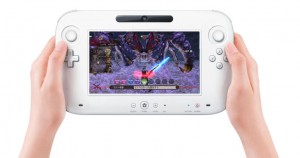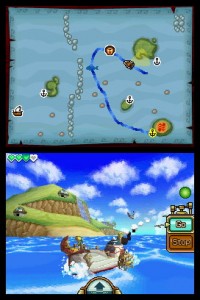The Potential of Wii U JRPGs
- Updated: 2nd Jan, 2013
Now that I’ve got my very own Wii U, played some of the games for myself and had some time to understand what it’s capable of, I’m incredibly excited for the possibilities opened up by the system for one of my favourite genres, JRPGs. Several launch window games have shown off the console’s potential and I have a few ideas of my own too. Without further ado, we venture into the unexplored land of the Wii U JRPG.
Removing the need to pause the action
In Mass Effect 3 on PS3 and 360, you have the ability to either leave your squad mates to make their own choices in battle, or you can control them directly. By pausing the action to bring up a command wheel you can select your squad member, select a command with the analogue stick then jump back to what you were doing. In the Wii U version, this functionality is available down on your touch screen. By removing that barrier of interrupting your immersion to stop and issue commands, you encourage experimentation and better strategies.
 When I played ME3 originally I barely used the Command Wheel, preferring to stay in the action. Now, with a quick movement to the touch screen, I can activate squad commands and keep myself in the action. Imagine the potential for games like Namco Bandai’s Ni No Kuni. Rather than having to pause the action and move through a mini menu to select which character you want, you could just have all of the selectable party choices on the bottom screen. Want to swap? Just tap and hey presto you’ve swapped on the fly without losing your momentum.
When I played ME3 originally I barely used the Command Wheel, preferring to stay in the action. Now, with a quick movement to the touch screen, I can activate squad commands and keep myself in the action. Imagine the potential for games like Namco Bandai’s Ni No Kuni. Rather than having to pause the action and move through a mini menu to select which character you want, you could just have all of the selectable party choices on the bottom screen. Want to swap? Just tap and hey presto you’ve swapped on the fly without losing your momentum.
Games like Xenoblade, with its large selection of battle commands, could use a similar system to allow you to command characters other than your lead character via a touch screen selection of their moves. Just put their command menu on the touch screen, and you can force them to use specific attacks if needed. It’s an easy way to allow people greater control over their squad.
The Mini Map and clearing the HUD
One of the mainstays of JRPGs since they joined the third dimension has been the mini map, with the larger and more featured map being hidden away in a pause menu. The beauty of having a second screen is that, like in ME3 Wii U, you can give players the option of having the gamepad screen function as a full map screen. You can see at any time where you are, where enemies are moving, where you need to go and even where cover is. Combine that with the ability of DS games like Phantom Hourglass to make notes on your map using the touch screen, and the Wii U could revolutionise how we traverse the world in JRPGs.
 While we’re on the subject, the ability to move other parts of your HUD to the gamepad such as health bars, mana and gold could really clear up the screen and allow for an even greater immersion into JRPG worlds.
While we’re on the subject, the ability to move other parts of your HUD to the gamepad such as health bars, mana and gold could really clear up the screen and allow for an even greater immersion into JRPG worlds.
Off-TV Play
Off-TV Play, the ability to play games entirely on the gamepad and free up the TV, has been one of the main features touted by Nintendo PR ever since the Wii U was first announced. When I first saw it demonstrated I was worried that it wouldn’t work for JRPGs, considering the amount of text, HUD and other information that is usually shown on screen. Having played several Off-TV Play compatible games including Assassins Creed III, Mass Effect 3 and New Super Mario Bros. U, I’m now convinced that the gamepad screen is more than up to the challenge.
While not as high a resolution as an HD TV, the small screen is able to handle the small details of Mario, the recharge bars and text overlays of Mass Effect and the text logs Assassins Creed with ease. Sure you wouldn’t get the uncluttered screen experience of using two screens, but the gamepad should have no problem handling JRPGs.
Turn-Based Battles
If you’ve played a Final Fantasy game, you’re probably aware of their love for turn-based battle systems where you select your commands, watch them play out, then select more. While I’m a fan of turn-based battle systems, I can see them being improved by the Wii U.
Imagine if a game moved the command selection down the the touch screen on the gamepad, and allowed you to queue moves up for one turn while the previous turn’s cinematics are still playing out on the TV. Faster players would be able to have the TV showing a constantly flowing battle with no stopping to select commands, creating amazing looking battle sequences that play out almost like a cutscene for others watching the TV.
Two-Screen Bosses
One of the highlights for me when playing Phantom Hourglass on the DS was when you’d occasionally get a boss battle that was so huge, you needed two screens to show it. The bottom of the boss was visible on one screen, and the rest on the other screen. Imagine having to have your adventurers battle their way up a giant creature, starting by attacking the legs on the gamepad, then climbing it to eventually attack the head on the TV.
Combine that with the gamepad gyroscopes that allow you to look around a scene by moving the gamepad and you could potentially even have bosses that periodically leave the TV screen’s view, forcing you to look around and find them. This opens up lots of new opportunities for interesting boss battles that wouldn’t be possible on any other system.
What do you think? Are we likely to see these implemented into future Wii U JRPGs? Have we missed out an idea that could really help the genre? Do you think any of those would be a bad idea? Would these changes be enough to make the Wii U your JRPG system of choice? Let us know your thoughts in the comments below.

Follow Us!